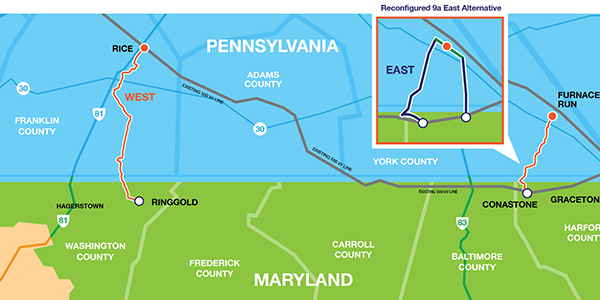By Christen Smith
Transource Energy filed a reconfigured version of the Independence Energy Connection project with Maryland regulators on Thursday as part of a settlement with state officials and landowners long opposed to the Ohio-based company’s original plans.
“We appreciate the state agencies, incumbent utilities and landowner input received when developing this alternative,” said Todd Burns, Transource’s director, in a statement emailed to RTO Insider. “We are pleased to present this alternative to the respective commissions for their consideration.”
Transource announced the settlement one week after Assistant Attorney General Sondra McLemore sent a letter to the Maryland Public Service Commission that indicated a finalized agreement between Transource and the state’s Power Plant Research Program (PPRP) would be filed “within four business days.” The company also filed a copy of the alternative configuration with the Pennsylvania Public Utility Commission and said regulators in each state will take both proposals into consideration.
Transource spokesperson Mary Urban said Wednesday that the company spent the summer modeling an alternate plan that would use existing infrastructure in the Baltimore Gas and Electric zone to revamp the eastern segment of the project, originally proposed to extend 15.8 miles from a new Furnace Run substation in York County, Pa., to the Conastone substation in Harford County, Md.
The updated configuration, designed in consultation with PJM, would increase the size of the new substation in Pennsylvania and add 4 miles of lines that would connect to an existing right of way and eventually feed into two upgraded BG&E substations. The settlement changes nothing about the western segment of the project, a 230-kV double circuit transmission line that would run 28.8 miles from Franklin County, Pa., into Washington County, Md.
If approved by state regulators, the deal would signal a major victory for the landowners united against the IEC. (See Protesters Doubt PJM Analysis of Transource Alternative.)
PJM selected the $383 million IEC — its largest market efficiency project to date — during the 2013/14 long-term planning window to address congestion in the AP South interface. The RTO has since reviewed its benefits to the grid five times, determining in each round that the project remains the most effective way to reduce load costs.
The RTO’s most recent analysis, completed in September, determined the IEC would generate a $856 million reduction in congestion costs over the next 15 years, with a benefit-cost ratio of 2.1 — well above PJM’s 1.25 threshold required for inclusion in its Regional Transmission Expansion Plan.
Protesters argued, however, that the need for the eastern segment of the project could be met by existing 230-kV lines. The PPRP urged the PSC to suspend the project while PJM studied the market efficiency of this alternative and three others — a request that was granted in January. (See More Info Needed on Tx Line Options, MD PSC Says and Cancel Transource Line, Md. Panel Says.)
PJM’s analysis determined that the protesters’ preferred configuration would require upgrades at the Furnace Run substation in order to alleviate potential reliability violations. The plan would cost $54 million to $94 million more than the IEC and produce $267 million less in congestion benefits to the region, it found.
Transource and the PPRP filed a joint petition in June to suspend proceedings regarding the company’s certificate of public necessity and convenience in order to reach a settlement on the eastern portion. The PSC granted a 30-day extension Aug. 27.
PJM staff told the Transmission Expansion Advisory Committee on Thursday that it’s unclear how the RTO will proceed if state regulators approve the alternative configuration — one that hasn’t been vetted by stakeholders or studied fully in the RTO’s planning process.




